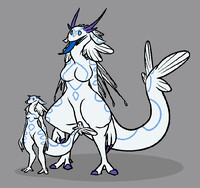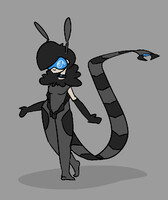
Ichthae Colour/Pattern Variations
// Life on Virisa-II has adapted to its unique atmospheric conditions in multiple ways. The world’s thick cloud layer and surface-level fog absorbs and diffuses much of the solar radiation it receives, including a majority of ultraviolet light. As a result, many of the lifeforms on the planet have very little pigmentation, leading to a pale or ghostly appearance.
The ichthae are a prime example of this. Ichthae have pale, very slightly translucent white skin that takes on a blueish tint from their blood. Additionally, their bodies sport assorted patterns, typically in the form of simple ovoid shapes across their head, tail, torso, upper arms, thighs, and tail. These patterns are commonly bioluminescent in nature but may be darkly pigmented instead in some populations. While blue is the most common colour displayed, patterns may range to turquoise or green as well.
Although increasingly displaced by their more intelligent cousins, “feral” ichthae populations often display comparatively simple and splotchy patterning.
Following the Eden Project’s genetic manipulation of their population of uplifted ichthae, a previously uncommon trait (resulting from genetic drift with the Titanoform snails that the ichthae traditionally used as macrohosts) gained much more prominent expression among certain ichthae populations. These variants bears significantly higher-than-normal pigmentation levels, resulting in a grey-brown skin colour, deep red tissues, and high-contrast patterning. They lack bioluminescence and instead display swathes of vibrant crimson paired with dark splotches. These high-pigmentation ichthae are sometimes known as infernus variants due to their “demonic”, fiery red-and-black appearance.
While a given pack will typically have a fairly consistent range of expressed patterning, interbreeding between stable populations can lead to many unique combinations. An example would be koi variants, which mix the pale look typical of most ichthae with the brilliant red patterning of infernus variants.
The ichthae are a prime example of this. Ichthae have pale, very slightly translucent white skin that takes on a blueish tint from their blood. Additionally, their bodies sport assorted patterns, typically in the form of simple ovoid shapes across their head, tail, torso, upper arms, thighs, and tail. These patterns are commonly bioluminescent in nature but may be darkly pigmented instead in some populations. While blue is the most common colour displayed, patterns may range to turquoise or green as well.
Although increasingly displaced by their more intelligent cousins, “feral” ichthae populations often display comparatively simple and splotchy patterning.
Following the Eden Project’s genetic manipulation of their population of uplifted ichthae, a previously uncommon trait (resulting from genetic drift with the Titanoform snails that the ichthae traditionally used as macrohosts) gained much more prominent expression among certain ichthae populations. These variants bears significantly higher-than-normal pigmentation levels, resulting in a grey-brown skin colour, deep red tissues, and high-contrast patterning. They lack bioluminescence and instead display swathes of vibrant crimson paired with dark splotches. These high-pigmentation ichthae are sometimes known as infernus variants due to their “demonic”, fiery red-and-black appearance.
While a given pack will typically have a fairly consistent range of expressed patterning, interbreeding between stable populations can lead to many unique combinations. An example would be koi variants, which mix the pale look typical of most ichthae with the brilliant red patterning of infernus variants.
Category Artwork (Digital) / All
Species Alien (Other)
Size 391 x 1280px
File Size 154 kB

 FA+
FA+







Comments